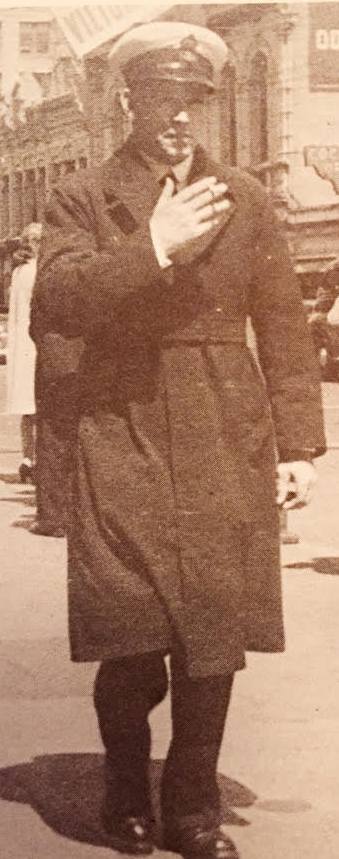Rank: Cook
Branch: Navy – Royal Canadian Naval Volunteer Reserve
Regimental Number: V/49455
Commemorated at Halifax Memorial, Nova Scotia
Henry Richard Fish (1873) and Annie Elizabeth (1879) were married in 1900 in England. Seeking a better life for his family that consisted of his wife, two daughters Norah (1901) and Muriel (1916) and son George, Henry decided to immigrate to Canada in July 1919. The family settled in Grande Prairie where Henry worked at various odd jobs. In 1921, he filed a homestead application on NE 35-70-6-W6; an area that was located just south of Grande Prairie. However, the application was subsequently cancelled. Eventually Henry found employment as a custodian for the Grande Prairie Courthouse; a position he kept for 10 years until his retirement in 1938.
George, who was born on January 7, 1907 in Lewisham, London, England, completed five years of public schooling before the family immigrated. Although he did not further his education once the family arrived in the Grande Prairie, he did work at several jobs until 1926 when he filed a homestead application on NE 6-73-2-W6 which was located on the banks of the Smoky River in an area of Bezanson known as Fitzsimmons. As George had learned carpentry skills from his father, he built a small house on the property and cleared a few acres of land. At one point he lived with the Proffitt family and helped build their home. George eventually cancelled the homestead application on the Fitzsimmons land after he had found what he thought was the perfect property for him. Consequently, he applied for a homestead application on NE 26-73-2-W6 in the Goodwin area in May 1932. George built a house out of poplar logs and worked off his farm in the summer months. In 1938, he bought Tom Mould’s trap-line, traps and cabins; the income from which was used to subsidize and improve the farm. George was very sociable and loved to play his harmonica at local events. As well, George was well-known for his cooking and housekeeping skills.
On October 23, 1942 George enlisted with the Navy at the H.M.C.S. Nosuch, a land-based naval establishment in Edmonton. His attestation paper stated he was 5’6” with brown hair, blue eyes and had a ruddy complexion. It also stated that he was a non-swimmer which was interesting to note as he had joined the Navy. George received his basic training at various naval bases: the H.M.C.S. Discovery in Vancouver, the H.M.C.S. Tecumseh in Calgary and the H.M.C.S. Naden in Esquimalt, BC. George was granted leave in 1943 to summer-fallow his farmland following which he served with the Royal Canadian Naval Reserve attached to the H.M.C.S. (Her Majesty’s Canadian Ship) Chebogue as a cook. George’s service file noted that he was a very capable, energetic and an extremely hard-working individual who was recommended for advancement. The H.M.C.S. Chebogue was assigned to the Mid-Ocean Escort Force. On October 4, 1944, during the ship’s second return trip to Canada, it was hit by a GNAT (German Naval Acoustic Torpedo) from the U-1227 submarine of the German Kreigsmarine (War Navy) when it was only 800 miles from the British Isles. Seven men were killed in the explosion of which George was one. Death was believed to be instantaneous and George was buried at sea the following day. The ship was towed to Port Talbot, Wales where it was declared a constructive loss and was eventually dismantled in 1948.
George is commemorated at the Halifax Memorial, Nova Scotia. The Memorial, located at Point Pleasant Park, was erected by the Commonwealth War Graves Commission to commemorate men and women who died in both world wars and have no known grave. It bears a cross that is mounted on a large podium that has bronze panels upon which are inscribed the names of 3,247 Canadian men and women who were buried at sea. George’s name is listed on Panel #13.
George’s mother, Elizabeth, received the Memorial Cross. George received the 1939-45 Star, Canadian Volunteer Medal & Clasp, Atlantic Star and the 1945 War Medal.
As George’s mother, Elizabeth was listed as his next-of-kin; she would have inherited his land and trap-line in the Goodwin area. The land was sold to Fred Mabbutt and the trap-line became part of Art Macklin’s farm.
Henry passed away in 1956 followed by Elizabeth in 1957. Both are buried in the Grande Prairie Cemetery. Their daughter, Norah, married Thomas Paul and resided in Grande Prairie while their daughter Muriel who married Jim Cobb, lived in Proctor, BC.
The Bezanson Community honours the memory of George Henry Fish – a young man who answered the call of duty to maintain the Country’s freedom and died in the effort to do so.
Written by Wanda Zenner
